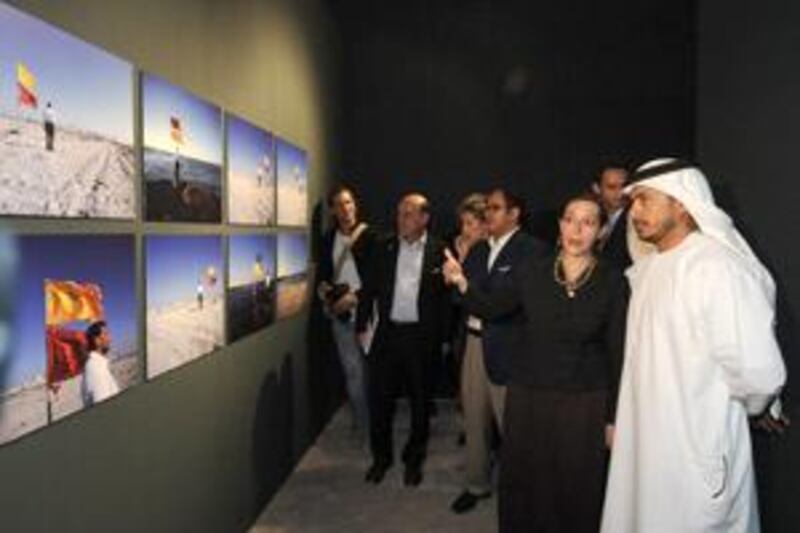Venice breeds bad habits in a critic. One ought to be patient, receptive, ready to attend to the meaning of even the most reticent works. But at the Biennale? Not a chance. There's too much art, too much sensation and spectacle competing for attention. Trigger-happiness sets in, a philistine indifference to the merely and quietly good. For example: Switzerland's national pavilion is a single-artist show by the painter Silvia Bachli. She specialises in works on paper, little doodles in pale watercolour, spacious, naive and tranquil. As I watched, another journalist entered the room, glanced into each corner, snorted and then left. I took that as my cue to do the same. Another time, perhaps.
The work that gets noticed is loud, flamboyant and, if possible, exclusive. It's no coincidence that perhaps the three most buzzed-about pavilions in the Giardini were the US, the UK and Denmark - all of which had the bright idea of getting visitors to queue to get in. Of course it can't have hurt the Danish effort, a mocked-up piece of high-end real estate, that they had a hyper-realistic mannequin lying face-down in a pond outside. This may not be what property agents commonly have in mind when they talk about kerb appeal, but it got people interested all the same.
The British pavilion featured a short film made by Steve McQueen, best known for the recent IRA drama Hunger, which depicted the death of Bobby Sands. His new effort, Giardini, was shot in off-season Venice and contains almost no human subjects. It's a remarkable piece of work - one which would have lost a great deal had it not been shown under properly cinematic conditions, with pre-booked screenings and no late admissions. A sort of photo-roman in the mould of Patrick Keillor's London and Robinson in Space, McQueen's film observes the gardens at dusk and dawn using a series of long, exquisitely composed and near-motionless takes. His camera manages to sniff out everything that is cold and crepuscular, hollow and anxious in its path, in the process turning Venice into something like one of Tarkovsky's mystic wildernesses. Skinny stray dogs nose in the rubbish. Earthworms haul themselves through gleaming black puddles. Lamps burn in the mist and shady figures meet for silent assignations. Nothing much happens, but it happens at a very high pitch of sustained tension. On a conceptual level, the film seems dashed off, almost whimsical. In the execution, it's gripping.
The American show managed a similarly remarkable feat of alchemy. Taken in isolation, Bruce Nauman's works come off as corrosive little chunks of madness, visual mantras that exist purely to make words stop making sense. On that basis, you might have expected several of them together to be rather hard to take. Yet this career retrospective seems somehow celebratory, even jovial. His best-known works play as comfortable classics. The seven deadly sins, pairs of superimposed neon antonyms ("gluttony/temperance", for instance, or "anger/fortitude"), adorn the pavilion's faux-Greco facade, giving it the look of a Mediterranean disco decorated by the Pet Shop Boys. Inside, the spiralling neon mirror-text of The True Artist Helps the World by Revealing Mystic Truths reads as sardonically as ever, but in a Nauman-only exhibition the irony seems more like self-deprecation than admonishment. Nauman has always been a funny artist, despite his austerity. The US show makes him look like a fun one, too. Even some of the most recent work on display - 2005's Three Heads Fountain (Three Andrews), in which suspended, flesh-coloured wax heads sprinkle water into a pool - produces a nostalgic glow. There aren't many straight-down-the-line absurdists left. Nauman is in danger of becoming a national treasure.
Among the other highlights from the Giardini were Nathalie Djurberg's The Experiment, located in the Italian pavilion. Billed as an installation, though that doesn't really convey the dimensions of the piece, Djurberg had created a sort of nightmare grotto of towering and misshapen Plasticine flowers, discordant music and claymation films - the latter, fever dreams of dismemberment and drowning, with lumpish figures getting the flesh torn from their bones by a sort of animate black ooze. The striking thing about it is how unconcerned with any sort of cerebral distance it seems to be: the intended effect is visceral and immersive, and it throws everything and the kitchen sink into achieving that. From the same pavilion, the British artist Simon Starling offers Wilhelm Noack oHG, a film in part about the manufacture of the projector on which it plays - a remarkable and elegant piece of equipment that threads its reel through a giant double-helix running from floor to ceiling. If that sounds too cutely circular and self-referential, the obvious joy taken in machinery, metalwork and the aesthetics of engineering goes a long way to offsetting it.
Heading over to the Arsenale, Daniel Birnbaum's Making Worlds exhibition - in many ways the centrepiece of the Biennale - contains too many fascinating things to do it justice in this space. Not everything works particularly well: Richard Wentworth's Untitled (2009), for instance, in which several black walking sticks are balanced by the hooks of their handles on a series of perspex shelves, seems very slight. But a great deal makes an impression, which is no small curatorial feat given the parade of cavernous rooms the show has to fill. Stand-outs include the Indian artist Sheela Gowda's Behold, in which a seemingly endless black rope of hair snakes and coils through the gallery, climbing a wall and tangling in a series of suspended chrome car bumpers. The effect is at once sensuous and faintly repellent, but the sight of it lodges in one's head in a peculiarly insistent way. Meanwhile the Cameroonian artist Pascale Marthine Tayou's installation Human Being @ Work goes out of its way to overwhelm the viewer. A mocked-up tribal settlement, it features wooden huts, giant spikes, fetishes, multiple projectors playing cacophonous films of life in poor-world villages, a mountain of shredded paper, hessian sacks filled with white powder and labelled "cocaine", plus half a dozen other provocations, all in the service of a frenzied and righteous agitprop. It's bravura stuff.
The Arsenale is also the home of the two shows from the UAE: a national pavilion and a separate platform presented by the Abu Dhabi Authority for Culture and Heritage. And while the exhibitions may differ in tone - the latter leans towards sober documentation whereas the former is full of postmodernist jokes - there's an intriguing kindredness in approach. The Adach platform introduces itself less as an art show than as a sort of preliminary audit of the UAE's cultural resources. With lots of images of life at street level, including photographic portraits of hitchhiking labourers by the Saudi artist Sami al Turki and a scrolling panorama of the country around Dubai sketched by Abdullah al Saadi, it aims to present the Emirates themselves, stripped of the glamour and mythology that has sprung up around them in the international imagination. The idea of the cultural stock-take finds its most literal expression in a full-scale recreation of one of the store rooms used by the prolific Emirati artist Hassan Sharif: its shelves are filled with sculptures and assemblages made from the commonplace materials of daily existence: clothes pegs, bottles, notebooks and twine. From such observations of the fabric of life at the human scale, the show suggests, the UAE's distinctive voice will emerge.
The national pavilion shares something of the Adach platform's preliminary character. Its centrepiece is a suite of photographs of one-star hotel rooms shot by Lamya Gargash, a collection that manages to achieve a mood of aesthetic detachment while still riffing goofily on the UAE's national profile, in particular, its fame for hyper-luxurious hotels. That tone of wry self-consciousness is the keynote of the pavilion, picked up by its most unusual feature, an audio guide which digresses into a humorous essay on the dilemmas of self-presentation facing a young nation. The rest of the exhibition intersperses artworks with architectural plans and video interviews on the UAE's development and destiny. There's a lot to take in, but the message is essentially a promissory note: watch this space. To which the only reply is, with pleasure.
elake@thenational.ae










